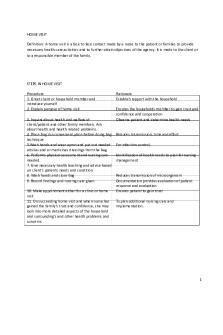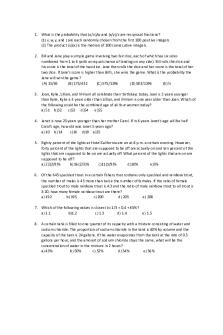Bag It movie questions PDF

| Title | Bag It movie questions |
|---|---|
| Author | Matthew Collins |
| Course | Physical Science |
| Institution | Arkansas State University |
| Pages | 2 |
| File Size | 59.4 KB |
| File Type | |
| Total Downloads | 5 |
| Total Views | 173 |
Summary
This assignment contains questions over the movie "Bag It." Some of these questions were on the last test before the final. Some of these questions were on the final as well. ...
Description
Bag It – is your life too plastic? 1. Where is “away”? There is no away 2. What is plastic made from? Made from fossil fuels 3. How does the film define a non-renewable resource? We won’t have that resource again 4. When did plastic become the wave of the future? 1977 5. What is the #1 consumer item in the world? Plastic bags 6. What did Ireland do to solve their bag problem? Placed a fee on plastic bags 7. What problems are plastic bags causing in India? Clogging storm drains 8. Name four countries and/or cities that have banned plastic bags. South Africa, Uganda, Austrialla, 9. Which was the first city in the US to place a fee on plastic bags? Washington D.C. 10. Why did San Francisco decide to use paper bags? 100% recyclable paper bags, so new trees are cut down 11. What are some ways to reduce the environmental impact of paper bags? Make them out of recyclable product 12. Explain what is meant by a “single-use disposable” item. It’s used once and that’s it 13. What are the big three? Soda bottles, plastic bags, and to go cups 14. How many disposable coffee cups are used every single day in the U.S? 3 million 15. How many pounds of packaging is the average American responsible for each year? 800 lbs 16. 60 million plastic bags are consumed in the U.S. every 5 seconds! 17. 2 million plastic bottles consumed in U.S. every 5 minutes! 18. 17 million barrels of oil are used each year just to make disposable water bottles! 19. In 2008, how much money was spent on bottled water? 12 billion 20. If a bottle is used to hold the amount of oil needed to produce AND transport it, how full would it be? Anywhere from ¼ of the way to ½ 21. What are some alternatives to recycling plastic soda bottles as is done in Germany? Paying people to rycycle and reusing those bottles 22. 71 barrels of oil is used to produce just 1 barrel of goods which are then thrown away at the curb. 23. How much waste does the average American produce each year? 1 ton 24. Recycles plastics in the U.S. are “downcycled”. What is meant by downcycling? Made into something to only use once 25. Where does most of our plastic recycling go to? Asia 26. You may have heard of the three R’s in making eco-conscious choices. What do they stand for? Reduce, Reuse, Recycle 27. What is the 4th “R” which is often ignored but often a better choice? 28. More plastic was produced just between the years 2000 to 2010 than during all of the 1900’s (a whole century!) 29. ________ of all ocean plastic debris starts from a land source. 80% 30. How many gyres of trash are around the world? 5 31. What do jellyfish eat? 32. What does it mean to photodegrade? It slowly breaks down into smaller particles that fish can mistake for food 33. What has been the highest plastic to plankton ratio measured? 40:1 34. What happens to the toxins in the fish? The plastic concentrates in their flesh 35. Each year, __________ new chemicals are approved WITHOUT TESTING for the manufacture of plastics. 125,000 36. In plastic manufacturing, what is the main use of phthalates? Used to soften plastic 37. In plastic manufacturing, what is the main purpose of BPA? Used to harden plastic
38. Why is there a growing concern over phthalates and BPA? They are endocrine disruptors, babies who took it show hyperactivity and can affect how they grow up. They can effect gender neutrality as well 39. In the body, BPA acts as a synthetic Estrogen. 40. Can you avoid BPA by only eating canned foods? Explain. No, canned foods are lined with BPA 41. In 200+ studies by the government, 92% percent show harm. In less than 20 studies by the plastics council, 0% percent show harm. 42. In which plastics are phthalates commonly found? Polyvinyl Chloride (PVC) 43. Are phthalates listed in personal care products? No 44. How did two days of regular exposure to common personal care products affect Jeb’s phthalate levels? On average, about 11 times 45. Can you avoid BPA if you buy foods contained in packaging other than plastic? Yes and no...
Similar Free PDFs

Bag It movie questions
- 2 Pages

BAG- Technique - RLE Bag
- 7 Pages

Movie Review - Use it wisely
- 12 Pages

Amistad Movie Questions
- 3 Pages

GLG 111 Movie Questions
- 3 Pages

3141 Contagion Movie Questions
- 3 Pages

Food Chains movie questions
- 1 Pages

Crude oil movie questions
- 2 Pages

Darwin Movie-Questions
- 2 Pages

Mixed Bag
- 4 Pages

Monuments Men Movie Questions
- 2 Pages

Before the Flood Movie Questions
- 1 Pages
Popular Institutions
- Tinajero National High School - Annex
- Politeknik Caltex Riau
- Yokohama City University
- SGT University
- University of Al-Qadisiyah
- Divine Word College of Vigan
- Techniek College Rotterdam
- Universidade de Santiago
- Universiti Teknologi MARA Cawangan Johor Kampus Pasir Gudang
- Poltekkes Kemenkes Yogyakarta
- Baguio City National High School
- Colegio san marcos
- preparatoria uno
- Centro de Bachillerato Tecnológico Industrial y de Servicios No. 107
- Dalian Maritime University
- Quang Trung Secondary School
- Colegio Tecnológico en Informática
- Corporación Regional de Educación Superior
- Grupo CEDVA
- Dar Al Uloom University
- Centro de Estudios Preuniversitarios de la Universidad Nacional de Ingeniería
- 上智大学
- Aakash International School, Nuna Majara
- San Felipe Neri Catholic School
- Kang Chiao International School - New Taipei City
- Misamis Occidental National High School
- Institución Educativa Escuela Normal Juan Ladrilleros
- Kolehiyo ng Pantukan
- Batanes State College
- Instituto Continental
- Sekolah Menengah Kejuruan Kesehatan Kaltara (Tarakan)
- Colegio de La Inmaculada Concepcion - Cebu



